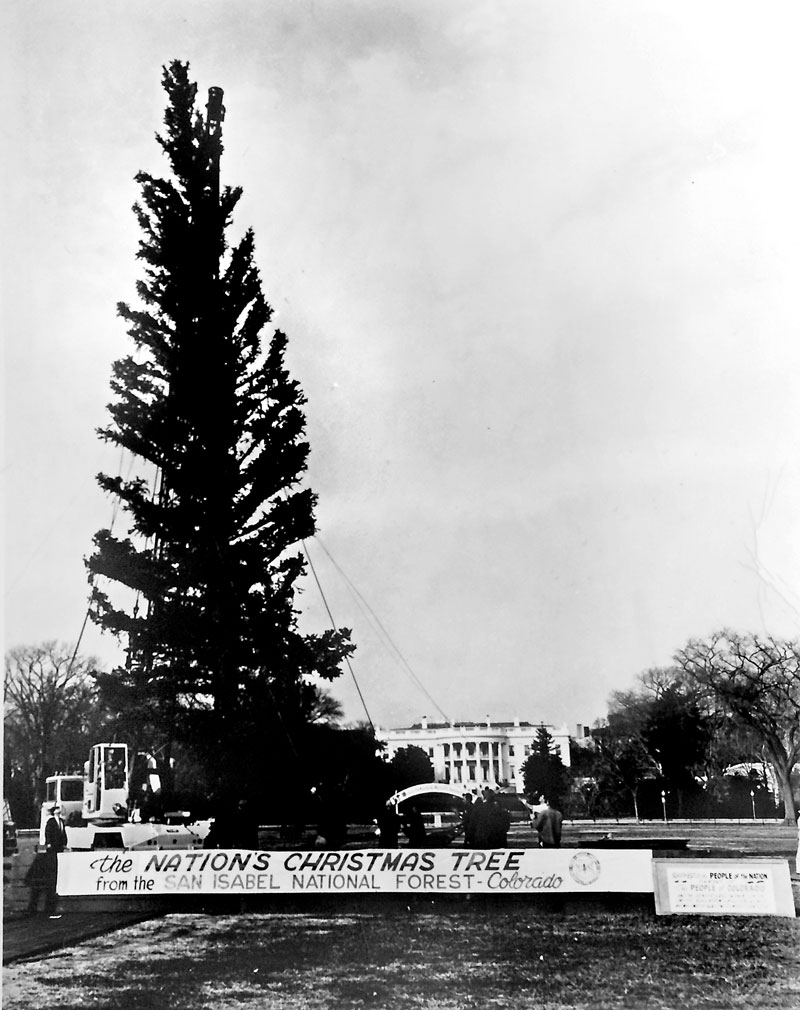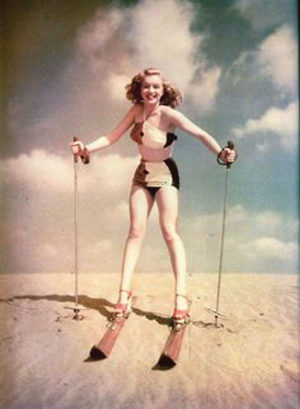By Mike Rosso
Deep in a ravine below a Forest Service road on Marshall Pass is a decaying wooden sign dedicated to the first National Christmas Tree harvested from Colorado. The large wooden sign reads: “The White House Christmas Tree for Peace. John F. Kennedy President 1962. The first White House Christmas Tree from Colorado.”
Dubbed, “The Tree of Peace,” the towering Spruce tree was felled in 1962 near the sign’s location along Silver Creek and trucked 1,765 miles to the White House lawn in Washington, D.C.
In the case of this tree, the term White House Christmas Tree is actually a misnomer. The tree, which was felled near Silver Creek, was actually designated as a National Christmas Tree. The White House Christmas Tree, also known as the Blue Room Christmas Tree, is the official indoor Christmas tree on display at the White House during the Christmas season, a tradition which began sometime in the 1850s. In 1962, the White House Christmas Tree was located at the North Entrance to the White House, and decorated with reused ornaments from 1961 plus other ornaments made by disabled and senior citizens.

The idea of a decorated, outdoor, National Christmas Tree came about in 1923 by Frederick Morris Feiker, a press aid to then-Secretary of Commerce Herbert Hoover. Feiker had been technical journalist for General Electric and had other connections with the electric industry. According to Wikipedia, The Society for Electrical Development (an electrical industry trade group) was looking for a way to encourage people to purchase more electric Christmas lights and use electricity, and Feiker suggested that President Calvin Coolidge personally light the tree as a way of giving electric Christmas lights prominence and social cachet. A 48-foot-tall balsam fir was donated by Paul Moody, president of Middlebury College in Vermont and alumnus of that college who paid for its delivery to Washington D.C. Apparently, the branches on the lower ten feet of the tree were damaged in transit, so branches were cut from a local evergreen and tied to the tree to restore its appearance.
That first National Christmas Tree was displayed on the Ellipse outside the White House in 1923. The U.S. electrical industry donated $5,000 worth of electrical cables which were buried under the Ellipse and provided the tree with the juice to run the lights.
The tree was decorated with more than 2,500 electric bulbs in red, white and green, donated by the Electric League of Washington. The event, complete with a 100-voice choir and nearly 10,000 spectators, was broadcast by the National Broadcasting Company. President Coolidge activated a button at the base of the tree to turn on the lights, but gave no speech. After all the white residents of the city had left, African American residents of D.C. were permitted on the park grounds to see the tree.
Things took a turn the following year. In 1924, Coolidge gave a speech to the American Forestry Association (AFA) in which he criticized cutting down trees for use as Christmas decorations. A live 35-foot Norway spruce was delivered to the capital, and was planted December 17 on the west side of Sherman Plaza by the AFA. It was again decorated with 1,000 red, white and green lights, plus white electric candles.
From 1924 on, the location of the tree and the ceremony changed multiple times. By the 1950s, the annual lighting ceremony for the National Christmas Tree was becoming more and more popular, with millions of Americans watching the ceremony on television. In 1954, a Pageant of Peace was proposed to coincide with the holiday ceremonies at the White House. The “pageant of peace” theme was intended to echo the words of the angels (“Glory to God in the highest, and on earth peace, good will toward men.”) The pageant did require that the Christmas tree be moved off the White House grounds and that the tree-lighting ceremony be moved from Christmas Eve to earlier in December, and the Ellipse became the site of the National Christmas Tree. Because Park Service officials felt a living tree would interfere with the various recreational and cultural events on the ellipse at other times of the year, they decided to return to the idea of cut trees.
The Pageant of Peace theme continued into the 1960s, but in 1961, President John F. Kennedy did not light the tree because his father, Joseph P. Kennedy, Sr., had suffered a major stroke, so Vice President Lyndon B. Johnson lit the tree instead. That tree featured lights which changed colors and brightness to syncopate with musical sounds from staged performers.
President Kennedy did light the National Tree on December 17, 1962 – the Spruce tree harvested from the San Juan National Forest – although the syncopated lights used in 1961 were not used again. It was the last time Kennedy lit the tree as he was assassinated on November 22, 1963, delaying the lighting of the National Christmas Tree until December 22 of that year.
Due to public pressure, live trees returned in the mid-1970s, and energy-conserving lights were used on the National Christmas Tree in 1974. The National Park Service had difficulties keeping these large trees alive after the transplant, and undertook a lengthy study to find a species of tree that could thrive in the climate and soil conditions of the capital and better withstand the annual decoration process. A tall blue spruce from Pennsylvania and one from New Jersey were planted on the Ellipse, and cables were used to help brace the trees against high winds. They did not last.
Subsequent living trees were either downed by bad weather or disease until October of 2012, when a 28-foot Colorado blue spruce from Virginia was planted as the new National Christmas Tree where it remains to this day.
But back to the sign at Marshall Pass. According to Ann Ewing, former public relations director for the Salida Ranger District U.S.F.S office, the commemorative sign was voluntarily constructed sometime in the 2000s by Roy Thompson and Bob Davis, two Salidans who worked under the Senior Community Service Employment Program for older Americans, and were fixtures at the Forest Service shop on C Street. Both retired Climax miners, “the boys” as they were affectionately referred to by the younger Forest Service employees, initiated this sign project, thinking it would be appropriate to note where the White House Christmas tree was cut. Originally, a different tree was cut near Buena Vista but it was damaged, so the Poncha Creek tree was selected. The two men hand-routed the sign at the C Street shop, installed it along Silver Creek and maintained it for many years. They were assisted in the sign maintenance by the late Brett Beasley, a U.S.F.S. employee who died in 2017. Roy passed away in 2001, and Bob Davis moved to Denver.


